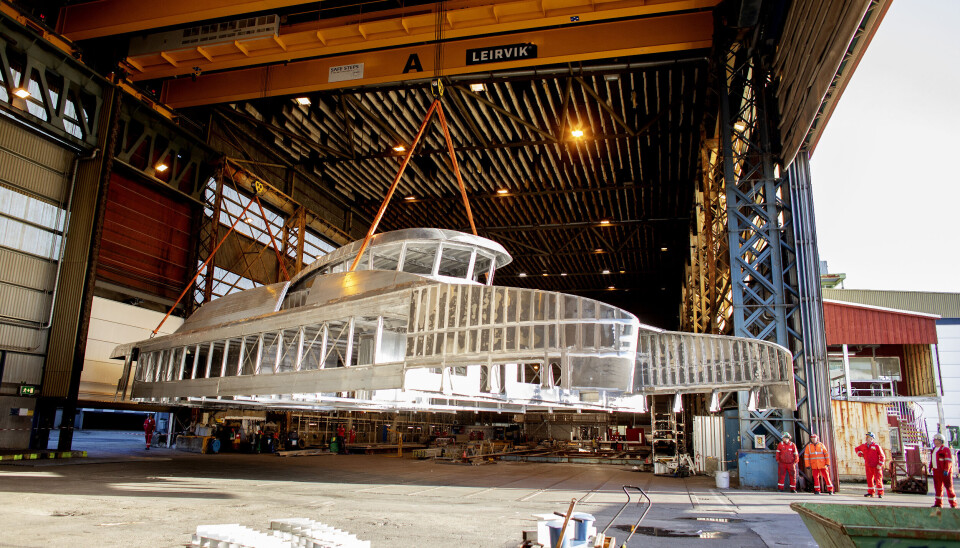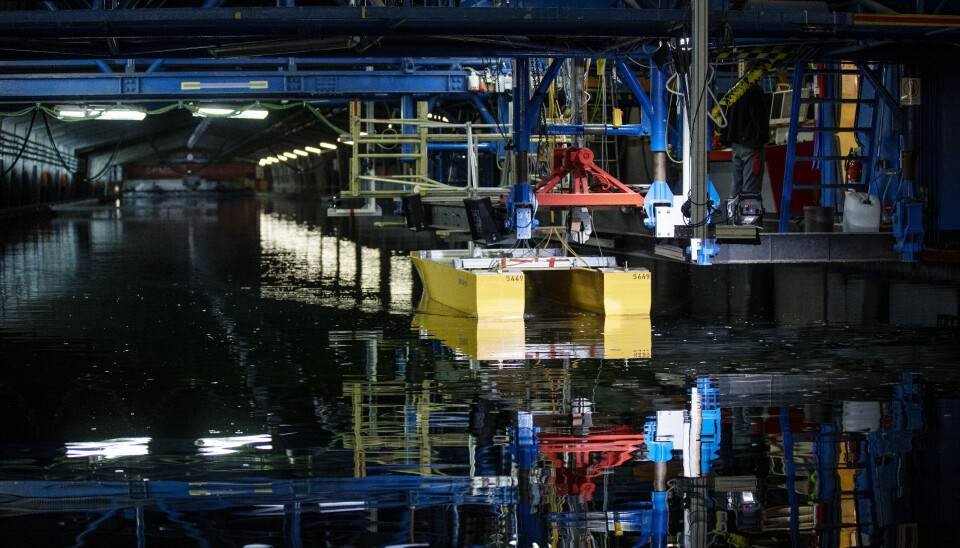
A dream of a fast ferry
The road has been long and challenging, which is natural when the goal is to create the world's first all-electric fast ferry. Before long, "Medstraum" will be at the finish line.
Denne artikkelen er tre år eller eldre.
There is good activity in the large yard area. Summer has taken a short break, and the clouds lie heavy with rain over a Hardangerfjord that is still slightly green with algae. Far out there, there are new tests of a vessel that will surely change both the rules of the game and the future of fast passenger boats, both at home and abroad.
Best in the world
I'm in Omastrand, a small village in Hardanger. But here they are equally used to finding solutions to major maritime and environmental challenges. It is approaching eight years since Fjellstrand delivered the battery ferry "Ampere", also the first of its kind. Today, everyone knows what it was the starting point for.
But electric propulsion on short ferry routes is one thing. Cracking the High Speed code, with only battery packs on board, is something else entirely.
“We must be able to say that Norway is the best in the world at staying at the forefront of technological development. And that Fjellstrand might be extra good. When things have become easy to put together, there are other countries that make it at a more reasonable cost than us,” Edmund Tolo summarises from the other side of the table. Just as sober and straightforward as the design of the meeting room we have placed us in.

A puzzle game
The dream of building a fast-moving electric boat has existed for some time.
“From a political perspective, there has been both a desire and a certain pressure to make this happen. But the risk of making the first one has also been reasonably high. Although it is Fjellstrand that builds the boat itself, it would not have been a reality without the involvement of the business cluster NCE Maritime Cleantech. They have simply gone up the road, used all the contacts and tools they have, and got an agreement in place where the boat will be delivered directly to Rogaland County Municipality. And not to a management team. It has been one of several important moments to get this done. Now we have collaborated and developed the fast ferry
shoulder to shoulder with Kolumbus/the county municipality,” explains Tolo.
Lots of good powers
But Fjellstrand has definitely also worked closely with teams from well-known partners in their western network, as well as receiving assistance for the more academic findings from the university environment in Scotland and Greece. And from the recognised model tank in Hamburg, HSVA.
“Leirvik AS has built a driver's cab and passenger module in razor-thin aluminium. Servogear is, as always, a crank pin when it comes to the propulsion system. Wärtsila has taken responsibility for the battery and energy technology, where Corvus is the battery supplier itself,” says Tolo.
But above and before all this, there is an EU initiative in the form of an allocation of around NOK 120 million from Horizon 2020 under the auspices of the Transport Advanced and Modular (TrAM) project.

As in the automotive industry
Although "Medstraum" has been optimised to work as well as possible on the trips between Stavanger city centre, Hommersåk and the city islands, the development process has just as much been characterised by the need to find more efficient production methods. Simply get a template in place.
“Not least because such boats tend to end up as stand-alone projects, where the next one has completely different goals and functions. Therefore, this time we are thinking completely new, and have targeted work to get modular solutions in place which can be scaled up and down, depending on the fast ferry in question. The thoughts and ideas behind it are very reminiscent of what you see from the car industry, where several car types are built on the same platform, with the advantages it also brings with it when it comes to reusing components.”
Battery on deck
For a long time, Tolo has been used to fast ferries that have been built around the diesel engine of choice at any given time. Now the engine is off, and you get a lot of freedom to think of new things.
“I think I have done something very well at "Medstraum". All batteries are located above the deck, and not down in the hull. There are several good reasons for this. One of them is that the size of the battery does not determine how big the hull should be. A fast ferry like this also has requirements for a double bottom. With a narrow hull, it is difficult to place the battery with the associated technical system down there. In addition, safety must be considered. If you end up in a collision, it is preferable to have the battery somewhere other than where seawater could potentially enter. The principle here is also a bit like in the car world. As is well known, the fuel tank is located in the safest place on the vehicle. Other advantages are that there is a shorter path to good air for cooling and ventilation. The battery will also be more easily accessible for both replacements, maintenance and daily inspection. The downside is that I lose a lot of space on the deck. But a fast ferry that runs on batteries will generally be quite a bit heavier than a normal diesel-powered boat. Therefore, the electric version should also be somewhat longer, and then you automatically get a little more space on deck,” says Tolo with a smile.

Longer and narrower
What does one do to get an optimal hull? Very often the answer is to make it longer and narrower. It has also been done with "Medstraum".
“A conventional diesel fast ferry that will take just under 150 passengers would normally be around 24 metres long. The battery version of this boat ends up at 30 metres, and is therefore significantly narrower. There is no doubt that I have put in place a hull design that is clearly better than what I have delivered in the past. And I can say that I feel very confident that we will deliver a fast ferry that fulfils the contract speed of 23 knots - with a good margin,” says Tolo, who is the man responsible for both research, development and sales at Fjellstrand.
Need 20 minutes
The battery pack on board is assembled from an extremely large number of small cylindrical units. We are talking about several hundred thousand batteries. These are packed in modules and put together in a rack, with a controller connected to each department. While ferries are charged from large boxes on the quayside, it is a bad fit for this revolutionary fast ferry. Again, one looks to the car industry, and the intention is to use six standard quick chargers (CCS 2) to fill up the "fuel tank".
“We had hoped that the development of larger chargers for the truck industry would be in place by now, but it will take some time. When they come, probably sometime in 2024/25, they will probably be useful in this connection. The solution, which will be used from the start, will do the job of recharging at the quay in Stavanger in around 20 minutes. Then "Medstraum" will once again have around one and a half megawatt hours on board, and be ready for another hour's quick round trip to the city islands and Hommersåk.
All or nothing
There are not many people who have experienced more development and more deliveries of fast ferries than Edmund Tolo. He came to Fjellstrand in 1985, and has since been involved in most of the ups and downs.
“Similar to MF "Ampere", there will also not be any diesel propulsion engine as a backup on "Medstraum". There will not even be a generator on board. Now we are talking about pure battery operation, which I have to rely on one hundred percent. That is the way it must go. When the diesel engines replaced the sails, it took 50 years before the masts were removed from the boats. The time when one transported unnecessary equipment is past. For someone who is a trained motor engineer, it is mostly a bit painful to say, but today's electric motors are probably more stable than the diesel engine has ever been. The important thing is to have good safety systems, and solid monitoring of the battery system.”

A new era
Although "Medstraum" is a project that involves many actors throughout Europe, it is now the traditional shipyard at Omastrand that has stitched together the ground-breaking final product.
“It feels good, and it hopefully gives us a good starting point for building new zero-emission passenger boats. At the same time, there are many who follow the project closely. Several routes are clear for similar vessels, and I believe that we are at the very beginning of a new era, for both us and our competitors. I think it is positive that there are many more people who want to invest in the same thing. Then there will also be a market for the supplier industry, because you cannot put the same equipment in a narrow and modern fast ferry as you do in large ferries and offshore vessels. We have much more to gain from the thinking and equipment used in the electrification of the car and aircraft industry. Our future will be very much about weight and optimisation. And about efficient, module-based design and production methods that will hopefully be well marked both in terms of construction time and price,” concludes Edmund Tolo.












